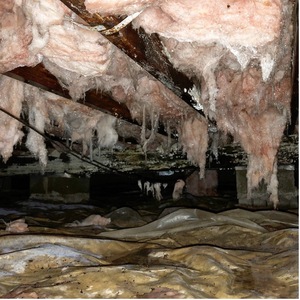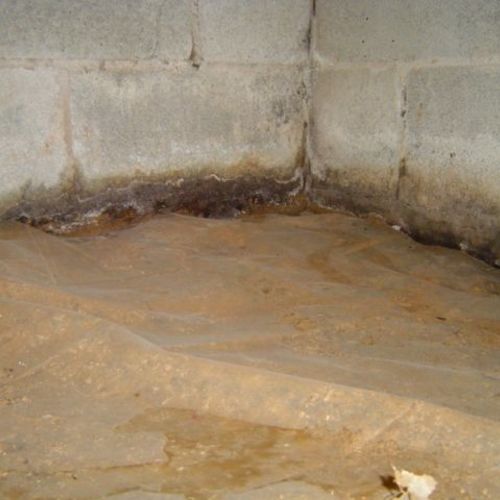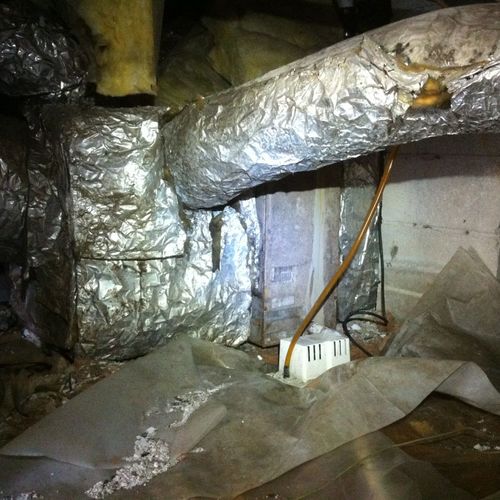
Image Credit: Energy Vanguard
Image Credit: Energy Vanguard This is from a house that was only a year or two old. Although the home builder had installed closed-cell spray foam insulation in all the above-grade walls and the attic, he left the crawl space vented to the outside. The result was mold growing on the HVAC system.
Image Credit: Energy Vanguard This supply vent coming off the trunk line in the beautiful crawl space shown above keeps the air cool and dry.
Image Credit: Energy Vanguard Dehumidifier in an encapsulated crawl space
Image Credit: Energy Vanguard A transfer grille between the house and crawl space can work well as long as the crawl space isn't used to store bad stuff like lawn mowers and pesticides.
Image Credit: Energy Vanguard
If you have a home with a crawlspace — or are building or buying one — you have several options on what to do with that particular foundation type. Most crawlspaces are vented to the outdoors, but over the past decade, encapsulating the crawlspace (as shown in the photo here) has gained favor among builders of green and energy efficient homes. It’s often seen as the best way to eliminate the moisture problems that often result from vented crawlspaces. But what do you do about the air down there?
Before we address that question, however, let me point out that encapsulated crawlspaces are great for humid climates, like the Southeastern U.S. In a dry climate, however, it may or not be worth the cost to encapsulate. So, as always, do what’s most suitable for your climate.
Basically, your options are to do one of the following:
- The tried and false method of venting the crawlspace to the outdoors
- Putting a little bit of supply air from the HVAC system into the crawlspace
- Using an exhaust fan to move air from the crawlspace to outside
- Installing a dehumidifier
Let’s take a look at each of these methods.
1. Vent the crawlspace to the outside
Do this in a humid climate, and you’re asking for trouble. The outside air that you bring into the crawl actually has more moisture in it than the crawlspace air you’re venting to the outside much of the time. Although the psychrometric chart shows mathematically why it doesn’t work, a look into just about any vented crawlspace in the Southeastern U.S. proves that venting to the outside is often a disaster.
The photo of the moldy humidifier below is from a house that was only a year or two old. Although the home builder had installed closed cell spray foam insulation in all the above-grade walls and the attic, he left the crawlspace vented to the outside. The result was mold growing on the HVAC system.
Let’s just say this is your worst option unless you’re in a dry climate and quickly move on to the better choices.
Conclusion: This is your worst option in humid climates. It’s probably also worst for most climates if the HVAC systems and ductwork are located in the crawlspace.
Supply conditioned air from the HVAC system
If you encapsulate the crawlspace, adding a little bit of air from the HVAC system is probably the most common method used. If there’s already a duct system down there, it’s easy and inexpensive to do. The air from the system helps to dry out the crawlspace air.
But it also puts the crawlspace under a slight positive pressure and the house under a slight negative pressure. Is that a problem? Not according to Advanced Energy‘s Closed Crawl Spaces guide:
In Advanced Energy field tests, the small crawlspace airflow causes a negligible pressure effect that is far exceeded by the effects of duct leakage, stack pressure or wind-induced pressures in the building.
How much supply air do you need to add to the crawlspace? Advanced Energy recommends 1 cubic foot per minute (cfm) for each 30 square feet of crawlspace floor area. The International Residential Code (IRC) recommends 1 cfm per 50 square feet:
Conditioned air supply sized to deliver at a rate equal to 1 cubic foot per minute (0.47 L/s) for each 50 square feet (4.7 m2) of under-floor area, including a return air pathway to the common area (such as a duct or transfer grille), and perimeter walls insulated.
If you go this route, it may work well in the summer if the air conditioner is sized properly. If the system runs long enough, it can provide enough dry air to the crawlspace to keep the relative humidity below 70%, where you want it.
In the swing seasons, however, and in homes with oversized air conditioners, this method may not work well. Another thing about this method that I’m not crazy about is that you’re conditioning the crawlspace based on the conditions in the finished space above. The crawlspace has its own conditions, though, and may or may not respond well to controls in another place.
Conclusion: Although it’s the most common method of treating the air in encapsulated crawlspaces, it may or may not work well.
3. Exhaust air to the outside
First, note that I’m not talking about the crazy idea to put large fans in the crawlspace to exchange large quantities of air between the outdoors and the crawl. (Yes, companies really do promote this, and it’s a quick way to rot the wood in your crawlspace.) I’m talking about a small exhaust fan, as described in the IRC. Here’s the language from the code:
Continuously operated mechanical exhaust ventilation at a rate equal to 1 cubic foot per minute (0.47 L/s) for each 50 square feet (4.7m2) of crawlspace floor area, including an air pathway to the common area (such as a duct or transfer grille), and perimeter walls insulated.
So a 2,000-square-foot crawlspace would need a 40 cfm exhaust fan. It’s pulling just a little bit of air from the crawlspace. The problem is that you don’t really know where the makeup air for the crawlspace is coming from. Yes, the code specifies a pathway for air to move into the crawlspace from the house, but air doesn’t always follow those arrows in the diagrams. If the band joist isn’t sealed well, for example, it may pull a lot of the air from outdoors, which isn’t really what you want.
Conclusion: It could work but is probably less reliable than supply air from the HVAC system.
4. Install a dehumidifier
In this method, you use a stand-alone dehumidifier for the crawlspace. (Again, we’re talking about encapsulated crawlspaces only; although some people try, you can’t dehumidify the whole outdoors.) It’s controlled by the conditions in the crawlspace, not the house above, so it this method will do the best job of keeping the crawlspace dry.
Brad Brinke of The Crawlspace Company in Virginia Beach responded to my question about this topic on our Facebook page: “We have a very good track record with the dehumidifier here in Virginia. We install a humidistat and fan system to help the dehumidifier operate efficiently. We tried using supply air from the home and it did not work.” (See the full discussion here.)
If you want dry air in your crawlspace, a dehumidifier is the way to go. Yes, they do have drawbacks. You have to buy additional equipment. They require maintenance. If the drain fails, you may have a bulk water problem in the crawlspace.
If it’s a small crawlspace, a standard dehumidifier that you can buy for $200 to $300 may be sufficient. For medium to large crawlspaces, however, it’s best to go with a more robust model, like the ones made by Therma-Stor. Their Santa Fe line is made for basements and crawlspaces. The dehumidifier photo below shows an older Santa Fe model made just for encapsulated crawlspaces.
Conclusion: Although more expensive, installing a dehumidifier is the best method for treating the air in an encapsulated crawlspace.
5. Connect the crawlspace to the house with a transfer grille
Both of the quotes from the building code that I mentioned above include the following language:
…including a return air pathway to the common area (such as a duct or transfer grille)…
What they’re saying is that if you pressurize the crawlspace with supply air or depressurize it with an exhaust fan, they want the crawlspace to be able to communicate with the house above to relieve the pressure. The easiest way to accomplish this is with a transfer grille right in the floor, as you see in the last photo below.
Advanced Energy isn’t a fan of this method, instead recommending that the entire floor be air sealed to isolate the crawlspace from the house. There are some good reasons for this. If, for example, the intent of the opening is for house air to move downward (as in the case of the exhaust fan), the stack effect may win out if the crawlspace isn’t perfectly sealed to the outside.
Another potential problem is pollutants in the crawlspace air migrating into the house. These could be soil gases such as radon or fumes from paints, pesticides, or fuel stored in the crawlspace. Also, if the crawlspace access door is left open, it may not be discovered for some time. Meanwhile, the house is directly connected to the outside through that transfer grille.
Is it ever OK to install a transfer grille? Sure. In the house where I took the photo above, there’s no access to the crawlspace from outside, and the owner (a guy who only recently learned the correct pronunciation of his name) doesn’t store hazardous chemicals down there (unless you consider wine hazardous).
Dr. Joseph Lstiburek, whose transfer grille you can see in the photos below, thinks that mixing house and crawlspace air is fine in some cases: “If your crawlspace is ‘clean,’ connecting it to the rest of the house is OK. If it is not clean then you should not do so. In trashed crawlspaces sucking on them with a continuous exhaust fan works well. In clean crawlspaces up North, transfer grilles work just fine. In between and in the South, a very small amount of return air works fine with a transfer grille as does a small amount of supply air with a separate fan that does not blow cold air from the HVAC system but blows house air that is warmer and drier.”
The bottom line
If I had to say one method was better than any other to deal with the air in a crawlspace, it would be to encapsulate it and install a dehumidifier. Adding supply air from the HVAC system can be tricky and may let the crawlspace humidity go too high in spring and fall. An exhaust fan may be OK in some cases. One thing I’d recommend above all else, though, is to monitor the air. Install a digital thermo-hygrometer with a remote sensor so the homeowners can keep an eye on what’s happening to the humidity levels there.
Now, go out there and turn those netherworlds into betterworlds!
Allison Bailes of Decatur, Georgia, is a speaker, writer, energy consultant, RESNET-certified trainer, and the author of the Energy Vanguard Blog. You can follow him on Twitter at @EnergyVanguard.
Weekly Newsletter
Get building science and energy efficiency advice, plus special offers, in your inbox.















5 Comments
Anything but vented
As a home inspector, I've seen everything listed installed in a crawlspace. I always prefer to see the HVAC used to ventilate. Fans that exhaust air to the exterior, fans that pull air through a transfer grill and dehumidifiers all have the same problem, maintenance. One day those fans and dehumidifier are going to quit working and unless the homeowner is very pro-active on maintenance, they will never know (What? you want ME to go in the crawlspace). With the HVAC system, when it quits, home owners are going to call someone to repair it. While it may not be the perfect solution, it's the system I know my customer will still have working long after the fans and humidifier failed. Installing a digital thermo-hygrometer with a remote sensor is a great idea but I think it would need some type of alarm (flashing display) to let the home owner know there is a problem, otherwise it's just something stuck on the wall you walk past everyday and pay no attention too.
Insulated floor?
What about insulating the floor like a non-vented ceiling, putting closed cell foam in the gradient zone where condensation could occur, and foam or rockwool in the rest, and air-sealing the bottom with fiberglass-faced gypsum board? Then leave the crawlspace vented. No build-up of radon and no energy usage heating or dehumidifying the space.
Response to Adam Liberman
Adam,
Your suggested approach can work in warm, dry climates. In a cold climate, you risk having frozen plumbing pipes. In all climates, you can't use your approach if you have any duct work in the crawl space, unless you are willing to tolerate the energy penalty that comes from locating ducts outside of the conditioned envelope.
In humid climates, your approach won't prevent moisture problems. During the summer, the humid exterior air will enter the crawl space and condense on the crawl space walls, making a damp, moldy mess.
More complete response to Adam please?
Adam mentioned radon build up. Other soil gases? It needs to be part of the solution: how? Install a spot ERV in the crawlspace? More maintenance.
Response to Paul Szymkiewicz
Paul,
Radon is a serious concern. If radon testing shows elevated levels of radon in your home, you should install a passive or active radon mitigation system.
I'm not sure what you mean by "other soil gases." Water vapor is one; it's a gas, and it should be controlled by a layer of polyethylene. If your house is built over a polluted site with industrial gases in the soil, you have specific problems that should be addressed by an environmental engineer.
I can't think of any reasons to install an ERV in your crawl space. I have never seen any expert recommend ERVs for crawlspaces.
Crawl space foundations have many problems -- so many problems that some building experts advise that we should never use them as a foundation system. That said, some buildings have crawl spaces, and we all have to come up with ways to make them work. Most of these approaches are compromises.
Log in or create an account to post a comment.
Sign up Log in